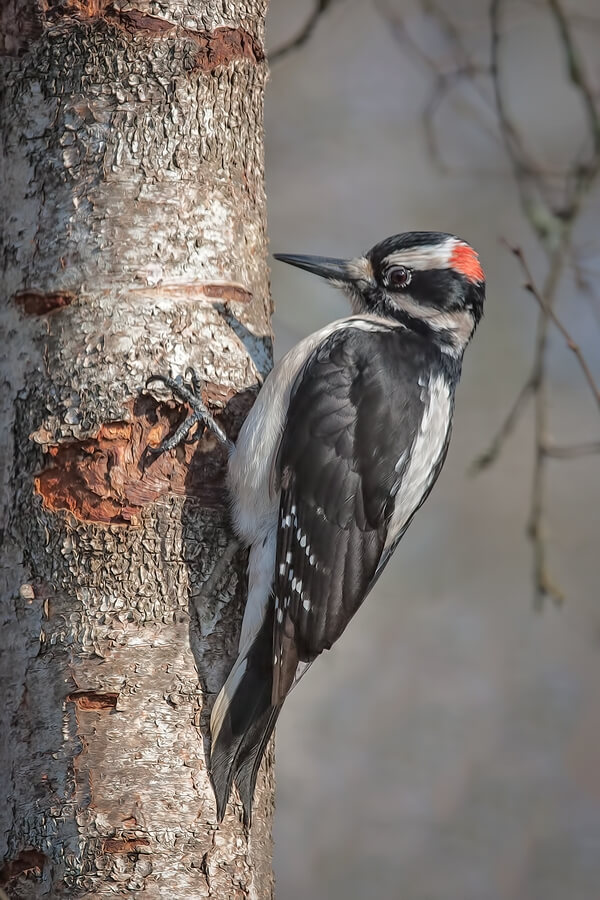Why Don’t Woodpeckers Get Concussions?
by Beth Peluso
Broadcast 9.24 and 9.27.2019

Hairy Woodpecker (Male), photo by Alan D. Wilson, naturespicsonline.com
Listen:
The mid-morning sun filters through the ponderosa pines as I follow a deer path through the forest. My walk is interrupted by a syncopated “thunk…thunk thunk” nearby. It doesn’t take long to locate the source—a male Hairy Woodpecker, Picoides villosus, on a half-dead ponderosa. (Picoides is from the Latin picus, meaning woodpecker, and villosus is Latin for shaggy or hairy.) The bird’s belly is white, and his head is wrapped with three black stripes (cap, eyeline, and moustache) from his bill to the red patch on the back of his head. His black wings have small white spots along the flight feather. From somewhere close by comes a resounding, rattling roll, like a tattoo on a small snare drum—another woodpecker drumming. The woodpecker I’m watching is too intent on breakfast to listen to the message. As I watch him pound away, I’m struck by a question: if he spends all day whacking his head against a tree, why doesn’t he get a concussion?
This is even more puzzling when you realize that for Hairy Woodpeckers, “woodpecker” isn’t just a description, it’s a lifestyle. They get about 45 percent of their food from drilling into trees. They also hollow out their own nesting cavities instead of taking over existing holes. A male Hairy Woodpecker can peck up to 190 strikes per minute when excavating a nest. That’s about 1/7 the speed of a jackhammer, which operates at about 1,300 strikes per minute. Woodpeckers also use drumming to communicate instead of singing. This long, rattling roll is produced by pecking rapidly on a surface with good sounding qualities, such as a hollow tree. Males and females use drumming to call a mate, declare territory, and threaten intruders. Sometimes breeding pairs will even drum duets to strengthen their bond. So with all this head-banging going on, why isn’t the forest floor littered with woodpeckers knocked silly?
The answer has to do with the size and shape of the woodpecker’s skull.
Sometimes Hairy Woodpeckers just use their necks to peck, which is a linear motion. In this case, they only have to worry about the impact force. But if they want a more powerful blow, they flex their back to use their whole body weight and their head moves through an arc. The arcing motion is exactly the kind of movement that is most likely to cause a concussion. To prevent injuries from these two types of motion, the name of the game is distributing force and keeping the brain tightly in place. The first protection the woodpecker has is simply size: the smaller the brain, the stronger the force needed to cause an injury. Literally being a bird brain is a safeguard against concussions. Second, the woodpecker’s skull is made of dense but spongy bone that tightly encloses the brain. Like a snug-fitting bike helmet, the spongy bone acts as a cushion during linear impacts.
Size alone, however, doesn’t completely account for Hairy Woodpeckers not losing consciousness during those arcing, full -body blows. This is where the shape of the skull comes into play. In flickers, ground-foraging woodpeckers, the brain cavity is pretty round. But in Hairy Woodpeckers, the brain cavity is more oblong. The oblong shape of the skull provides more support for the brain so it won’t rotate during an arcing movement. The Hairy Woodpecker can bash a tree as hard as he likes and not spend half a day unconscious on the forest floor.
But that’s not all. Hairy Woodpecker skulls and bills are designed to work together to prevent the impact of a blow from even reaching the brain. (The bill itself is straight, in comparison to the slight curve of a flicker’s.) A hairy’s bill is also wider at the base as compared to its length than a flicker’s bill, which allows force to dissipate through a slightly larger area of the skull. Even the position of the upper bill helps deflect the effect of the impacts. It lines up neatly with the base of the brain cavity so the force can be transferred directly to bone that leads to the back of the skull, bypassing the brain entirely.
The little Hairy Woodpecker I’m watching doesn’t seem at all concerned about skull structure and head injuries. He’s intent on the second course of breakfast. He flits over to a dead tree and begins working his way up the side, thunking away as he goes.
Every week since 1991, Field Notes has inquired about Montana’s natural history. Field Notes are written by naturalists, students, and listeners about the puzzle-tree bark, eagle talons, woolly aphids, and giant puffballs of Western, Central and Southwestern Montana and aired weekly on Montana Public Radio.
Click here to read and listen to more Field Notes. Field Notes is available as a podcast! Subscribe on iTunes, Google Play, or wherever you listen to podcasts.
Interested in writing a Field Note? Contact Allison De Jong, Field Notes editor, at adejong [at] montananaturalist [dot] org or 406.327.0405.
Want to learn more about our programs as well as fun natural history facts and seasonal phenology? Sign up for our e-newsletter! You can also become a member and get discounts on our programs as well as free reciprocal admission to 300+ science centers in North America!












